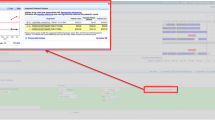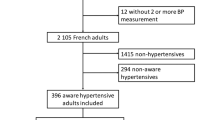Abstract
Objective: To estimate the impact of clinical and non-clinical predictors of patterns of medication use and expenditures for the treatment of hypertension in the USA.
Data Sources: The 1987 National Medical Expenditures Survey was used to identify 6398 individuals with hypertension over the age of 18 years. Pharmacological treatment was identified through patient self-reports of antihypertensive medications.
Study Design: This retrospective, cross-sectional study used a multivariate two-stage decision model to estimate the demand for antihypertensive medications conditional on receipt of at least one antihypertensive prescription drug.
Results: Women and the elderly were more likely to obtain medications and had greater expenditures on antihypertensive medications. Privately insured patients were 59% (if non-elderly) or 163% (if elderly with Medicare) more likely to receive drug therapy than uninsured patients. Patients with only Medicaid coverage were 126% more likely to receive drug therapy than uninsured patients.Compared with patients characterised as lower risk-takers, very high and high risk-takers were 38% and 24% less likely to be on drug therapy, respectively. Black, non-Hispanics were 30% more likely to be on drug therapy than White, non-Hispanics, but had lower annual expenditures on antihypertensive drugs. Severely overweight individuals [bodymass index (BMI) >30] were 62% more likely than patients with a BMI <27 to be on drug therapy and also had higher drug expenditures.
Conclusions: Insurance had a more striking effect on access to antihypertensive drug therapy than on patterns of drug use or expenditures. Race/ethnicity and patient attitudes towards risk were important determinants of access to antihypertensive drug therapies, as well as patterns of drug use and expenditures.




Similar content being viewed by others
Notes
1The Anatomical Therapeutic Classification is a system of drug classification developed by the Scandinavian countries and adopted by WHO (for further information on the classification, the reader can consult WHO website at http://www.whocc.nmd.no).
2CHAMPUS is a programme that covers the medical expenses of dependents of active-duty personnel in the US military.
3Coefficient of determination.
References
Burt VL, Whelton, PK, Roccella EJ, et al. Prevalence of Hypertension in the US adult population: results from the Third National Health and Nutritional Examination Survey, 1988–1991. Hypertension 1995; 25: 305–13
American Heart Association. American Heart Association’s Heart and Stroke Facts. Dallas (TX): American Heart Association, 1997: 3–28
Schlesinger M, Mechanic D. Challenges for managed competition from chronic illness. Health Affairs 1993; 12 Suppl: 123–37
Shepard DS, Stason WB, Mitchell PH, et al. Multivariate cost effectiveness analysis: an application to optimizing ambulatory care for hypertension. Inquiry 1995; 32: 320–31
McManus MA, Newacheck P. Health insurance differentials among minority children with chronic conditions and the role of federal agencies and private foundations in improving financial access. Pediatrics 1993; 91 (5 Pt 2): 1040–7
Blaum CS, Liang L, Liu X. The relationship of chronic diseases and health status to the health services utilization of older Americans. J Am Geriatr Soc 1994; 42: 1087–93
Hornbrook MC, Goodman MJ. Chronic disease, functional health status, and demographics: a multi-dimensional approach to risk adjustment. Health Serv Res 1996; 31(3): 283–306
Newacheck PW. Poverty and childhood chronic illness. Arch Pediatr Adolesc Med 1994; 148: 1143–9
Fishman P, Von Korff M, Lozano P, et al. Chronic care costs in managed care. Health Affairs 1997; 16(3): 239–47
Watt S, Roberts J, Browne G, et al. Age, adjustment and costs: a study of chronic illnesses. Soc sci Med 1997; 44(10): 1483–90
Grana J, Stuart B. The impact of Insurance on access to physician for elderly people with arthritis. Inquiry 1997; 33: 326–38
Moy E, Bartman BA, Weir W. Access to hypertensive care, effects of income, insurance and source of care. Arch Intern Med 1995; 155: 1497–502
Newhouse JP. Free for all. Cambridge MA: Harvard University Press, 199313
Huttin C, Avorn J. Drug expenditures for hypertension: an empirical test of an economic model in a French population. Cah Sociol Demogr Med Jan–Mar; 1997; 37(1): 33–52
Havas S. The high cost of lost opportunities for prevention. JAMA 1997; 277(5): 375–6
Joint National Committee. The Sixth Report of the Joint National Committee on Detection, Evaluation and Treatment of High Blood Pressure. Arch Int Med 1997; 157: 2413–46
U.S. Department of Health and Human Services. The Health Benefits of Smoking Cessation. A Report of the Surgeon General. Center for Chronic Disease Prevention and Health Promotion, Office on Smoking and Health. DHHS publication no. (CDC) 90-8416. Rockville (MD): Center for Disease Control, 1990
Puddey IB, Parker M, Beilen LJ, et al. Effects of alcohol and caloric restrictions on blood pressure and serum lipids in overweight men. Hypertension 1992; 20: 533–41
Gill JS, Shipley MJ, Tsementzis SA, et al. Alcohol consumption-a risk factor for hemorragic and non hemorragic stroke. Am J Med 1991; 90: 489–97
U.S. Department of Health and Human Services. Physical Activity and Health: A Report of the Surgeon General. National Center for Chronic Disease Prevention and Health Promotion. Atlanta (GA): Center for Disease Control and Prevention, 1996
Stafford RS, Blumenthal D. Primary care specialty differences in cardiovascular disease prevention practices. J Am Coll Cardiol 1998; 32: 1238–43
Meigs JB, Stafford RS. Cardiovascular disease prevention practices by U.S. Physicians for patients with diabetes. J Gen Intern Med 2000; 15: 220–8
Stafford RS, Pasternak R, Blumenthal D. Variations in the cholesterol management practices of U.S. physicians. J Am Coll Card 1997; 29: 140–7
Edwards W, Berlin M. Questionnaires and data collection methods for the household survey and the survey of American Indians and Alaska natives. DHHS publication No.(PHS) 89-3450. National Center for Health Services Research and Health Care Technology Assessment, Rockville (MD): Public Health Service, 1989
Siegel D, Lopez J. Trends in antihypertensive drug use in the United States: do the JNC V recommendations affect prescribing? Fifth Joint National Commission on the Detection, Evaluation, and Treatment of High Blood Pressure. JAMA 1997 Dec 3; 278(21): 1745–8
Duan N, Manning W, Morris CN, et al. A comparison of alternative models for the demand for medical care. J Bus Econ Stat 1983; 2: 115–26
Newhouse JP, Manning W, Morris CL, et al. Some interim results from a controlled trial of cost sharing in health insurance. Santa Monica (CA): The Rand Corporation, 1982
Iglehart JK. The American health care system. Introduction. N Engl J Med 1992 Apr 2; 326: 962–7
Executive Office of the President, Health Security Act, H.R. 3600/S. 1757, 1993;Nov 20, 1993
Soumerai S, Ross-Degnan D. Inadequate prescription-drug coverage for Medicare enrollees — a call to action. N Engl J Med 1999; Mar 4; 340: 722–8
Cutler D, Mcclellan M, Newhouse J, et al. Pricing heart attack treatments. National Bureau of Economic Research Summer conference paper, Boston, Julyl998
Taylor DW. A test of the Health Belief Model in hypertension in Compliance in health care edited by Haynes RB, Taylor DW, Sackett DL. Baltimore: The Johns Hopkins University Press, 1979
Breckenkamp J, Laaser U, Meyer S. Die Deutsche Herz Kreislauf praventionstudie: sozialer gradient bei den nettoeffekten in der Pravention der Hypercholesterinamie. Z Kardio; 1995; 84: 694–9
Acknowledgements
The research was partly supported by a research grant from the Agency for Healthcare Research and Quality (AHRQ) [R03 HS09538]. We also gratefully acknowledge the assistance of Jane Faulman of Social and Scientific Systems for data processing services in constructing the data base for the study, and the Harvard School of Public Health, in particular Dr Alec Walker for advice on pharmacoepidemiology, and Sidney Atwood for technical computer assistance. We also thank Steven Cohen, Alan Monheit and John Fleishman for helpful comments on an earlier draft of this paper. The views expressed in this paper are those of the authors and do not represent the views or policies of either the AHRQ or the US Department of Health and Human Services.
Author information
Authors and Affiliations
Corresponding author
Rights and permissions
About this article
Cite this article
Huttin, C., Moeller, J.F. & Stafford, R.S. Patterns and Costs for Hypertension Treatment in the United States. Clin. Drug Investig. 20, 181–195 (2000). https://doi.org/10.2165/00044011-200020030-00006
Published:
Issue Date:
DOI: https://doi.org/10.2165/00044011-200020030-00006




